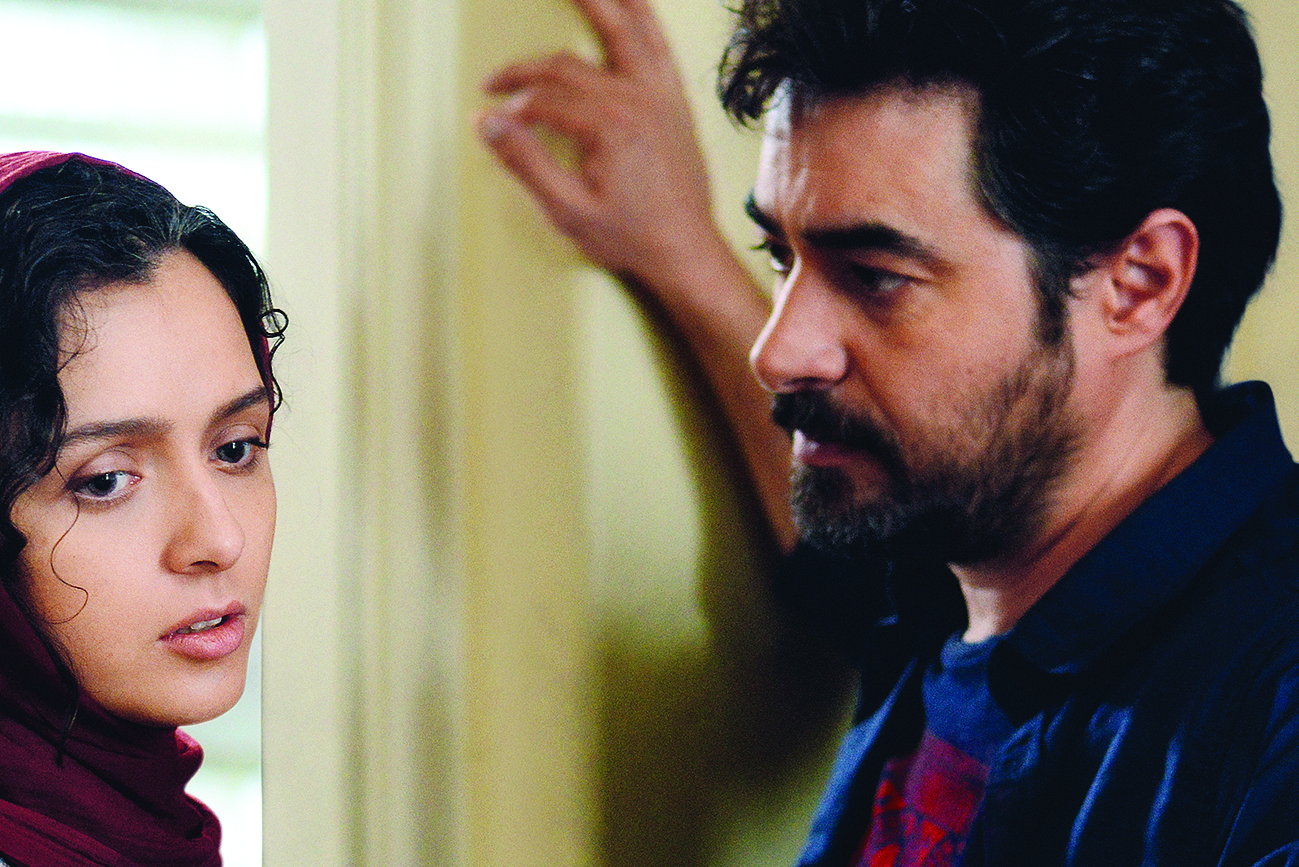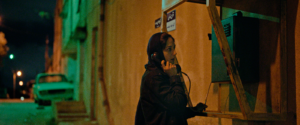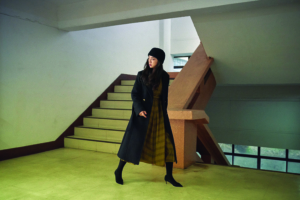Asghar Farhadi’s The Salesman (2016) opens with a literal bit of stage-setting. In a series of tight shots, the camera delineates several sections of a theatrical set – bed, table, doorway – that fit together as the performance space for a community production of Arthur Miller’s Death of a Salesman. The sequence concludes as the key lights are raised to illuminate the space, as though the show were about to begin.
The next scene introduces Emad (Shahab Hosseini, who won Best Actor at the 2016 Cannes Film Festival for the role) and Rana (Taraneh Alidoosti) – husband and wife, and the key performers in the Salesman production as Willy and Linda Loman – as they become homeless, their comfortable apartment building having had its foundations undermined by construction work adjacent to it, precipitating a panicked exodus by its residents in the middle of the night. In the wake of this unceremonious eviction, Emad and Rana are offered the tenancy of a recently vacated, and mildly shabby, top-floor apartment by Babak (Babak Karimi), a fellow cast member. It soon becomes clear that the previous occupant, a single mother, was – in the delicate terminology of their neighbours – a woman who ‘lived a wild life’, with a regular procession of male visitors. One night, while Rana is home alone, she buzzes up a caller, believing it to be Emad, and is attacked in the shower. Following this assault, the couple struggles to regain some sense of emotional equilibrium as Emad grows frustrated with Rana’s traumatised responses and becomes fixated on tracking down her attacker.
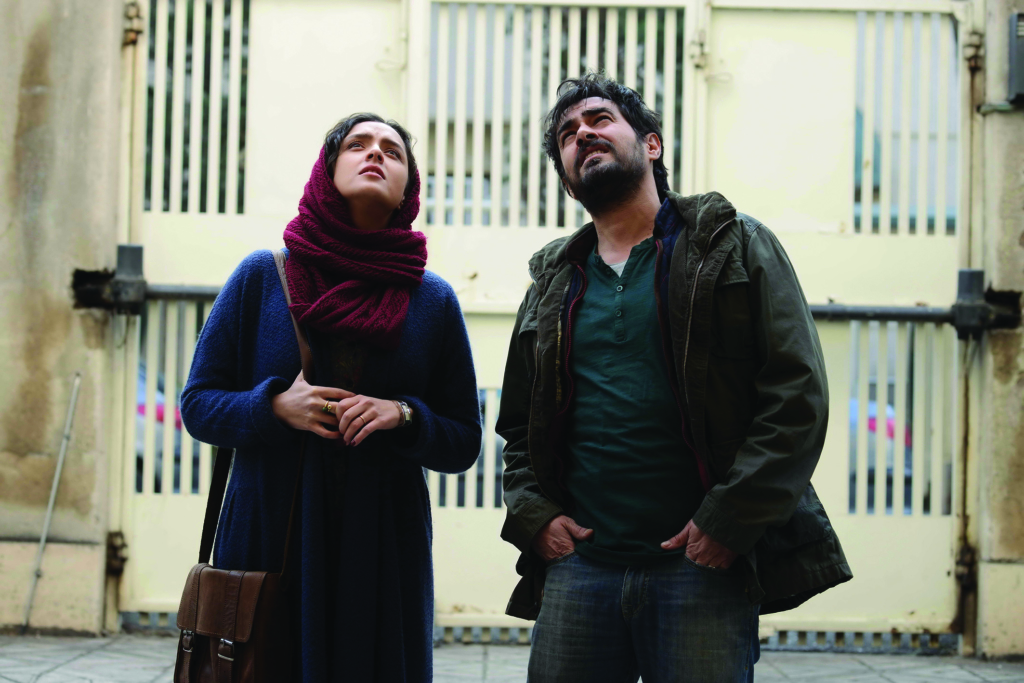
The Salesman production is clearly key to Farhadi’s design for his film, but, if there’s a substantial narrative connection between Emad and Rana’s story and Miller’s play, it swept right by me. It seems to have done the same for many critics – David Jenkins, writing in Little White Lies, for instance, describes the relationship between the two as ‘subtle to the point of irrelevance’.[1]David Jenkins, ‘The Salesman – First Look Review’, Little White Lies, <http://lwlies.com/festivals/the-salesman-first-look-review/>, accessed 16 February 2017. Yet, though the narrative resonances might be oblique, Farhadi still puts this theatrical conceit to work. The minimalist set for the play – with bare pipes stretching across the stage, the Lomans’ house dissected for the audience – suggests a reinforcement of the thematic thrust of the apartment building’s almost-collapse: here is a home, a family, exposed and in a state of deconstruction.
The minimalist set for the play – with bare pipes stretching across the stage, the Lomans’ house dissected for the audience – suggests a reinforcement of the thematic thrust of the apartment building’s almost-collapse: here is a home, a family, exposed and in a state of deconstruction.
It also offers Farhadi a forum for some delicate commentary on the content restrictions that come from making a film in his native Iran. In an early rehearsal scene, one cast member breaks into laughter at the incongruity of the actress playing Miss Francis reciting dialogue proclaiming her state of near-undress while being obliged to perform in full clothing, with a heavy overcoat. On the night of her assault, Rana is home alone because Emad has stayed back at the theatre in order to discuss the production with a state censor, who is threatening to redact three additional passages from the play. Writing for Filmmaker Magazine, Vadim Rizov suggests:
In noting the censorship applying to as comparatively innocuous (from a Western POV, anyway) and old a property as Death of a Salesman, Farhadi’s movie foregrounds awareness of the far more potentially censorable narrative it has to carefully thread through Iran’s rules for public cultural expression.[2]Vadim Rizov, ‘TIFF Critic’s Notebook 0: The Salesman, Aquarius, Things to Come, Elle’, Filmmaker Magazine, 7 September 2016, <http://filmmakermagazine.com/99464-tiff-critics-notebook-0-the-salesman-aquarius-things-to-come-elle/>, accessed 16 February 2017.
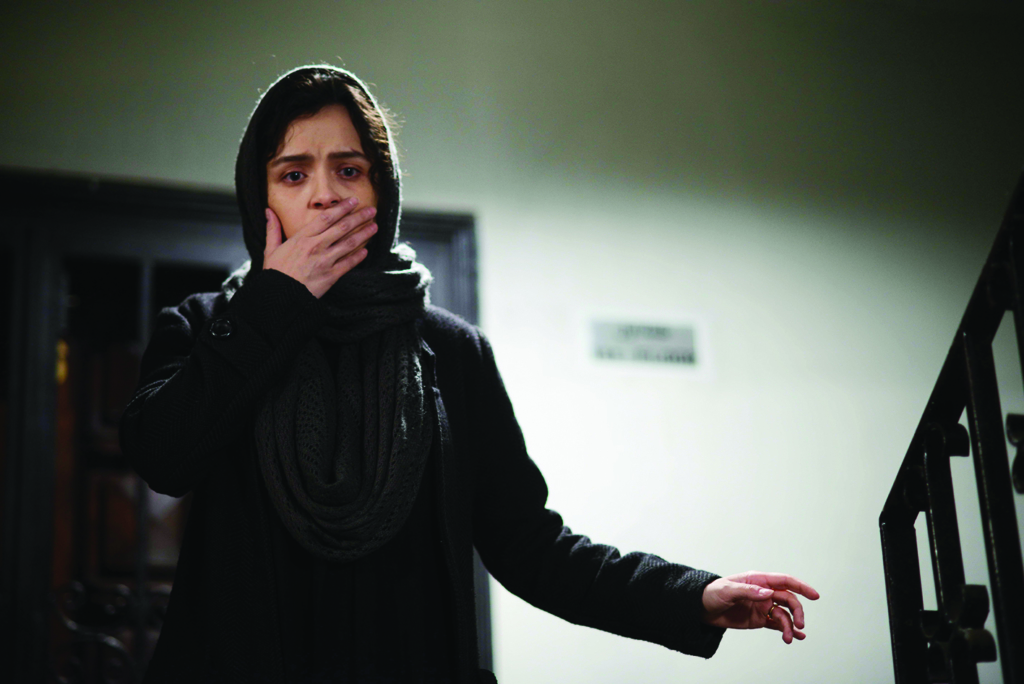
Farhadi’s dance with the censors – and its consequences for his plot – becomes a constitutive element in the film’s central drama, which focuses on the ambiguity around what happened to Rana.
Circumstances clearly suggest rape, but the characters are as emotionally unable to discuss this possibility as Farhadi’s film is politically unable to depict it, and the angst caused by this ambiguity drives a lot of Emad’s reckless actions in the second half of the film. Returning home on the night in question, he finds a trail of bloody footprints on the stairs leading to the apartment, and more blood in the bathroom. He finds Rana at the hospital, where she is receiving stitches for a wound on her head, and learns about some of the events of the evening from their neighbours, who stop short of specifying the state in which they found his wife. Later, Rana inconsistently claims to have blacked out upon becoming aware that a stranger was in the bathroom with her, while also freezing up during a performance of Salesman upon noticing that a member of the audience had ‘the gaze’ of her attacker. Her contradictory responses, though psychologically congruent with the nature of trauma, add fuel to the fire of Emad’s increasingly vengeful state of mind.
The Salesman, as with Farhadi’s previous two films, transforms slowly from a domestic drama into a kind of detective story … That this investigation rides roughshod over the woman’s reasons for concealing that experience is part of Farhadi’s tacit critique of his male characters.
Rana’s, or Farhadi’s, disinclination to offer a full account of what happened to her has posed a problem for some critics. In The Village Voice, Bilge Ebiri suggests that the film’s equivocating masks a ‘noxious political core’:
its inciting incident seems to reaffirm conservative Islam’s worst ideas about uncovered and ‘loose’ women. It’s not that I think Farhadi shares such beliefs, but he uses them as poetically vague elements in an effort to manhandle a very specific (and occasionally contrived) plot into place, like a fable that’s suddenly been brought up for interrogation.[3]Bilge Ebiri, ‘Cannes 2016 Winners Highlight the Gulf Between Critics and the World’, The Village Voice, 23 May 2016, <http://www.villagevoice.com/film/cannes-2016-winners-highlight-the-gulf-between-critics-and-the-world-8651054>, accessed 16 February 2017.

Yet Farhadi’s ‘manhandling’ of his plots is also a key element of his style. Film critic Mike D’Angelo has called him ‘the greatest dramatist in the world at the moment’,[4]Mike D’Angelo, ‘Closing Cannes with Farhadi, Verhoeven, and Best-of-the-fest Picks’, The A.V. Club, 21 May 2016, <http://www.avclub.com/article/closing-cannes-farhadi-verhoeven-and-best-fest-pic-237141>, accessed 3 March 2017. and part of the satisfaction of watching his films is waiting to see exactly how his intricately constructed narratives build and pay off. ‘Chekhov’s gun’ – the rifle that, having been brought on stage in the first act, must be fired by the third – is a common old saw about sturdy dramatic construction, but Farhadi’s films are like escalating Jenga towers of such guns: a series of props, claims and actions that linger in the dramaturgical background, waiting to go off and force the plot into fresh emotional territory.
Several such elements litter the back half of Salesman. In the days following Rana’s assault, Emad discovers hints of her attacker’s identity across their apartment: first, a pair of socks, then a mobile phone, and a set of keys that unlocks a ute parked on the street outside, and finally a stack of money left neatly on their bedroom shelf. The outrage this payment represents leads to one of Farhadi’s typically ingenious dramatic turns, during a scene in which the couple cook dinner for the young son of a cast-mate – one of their first moments of emotional rapprochement since the attack. Mid-meal, Emad realises that Rana has found the stack of cash he hid in a drawer, and paid for the food using the attacker’s money; their enjoyment of the meal quietly sours.
The other clues enable Emad to ultimately track down and confront the attacker, whom he invites to his old apartment under the pretence of using the ute for a small removalist job. The resulting showdown – with Emad and Rana at odds over what to do with their nemesis – exemplifies Farhadi’s ability to twist emotional confrontations into agonising zero-sum scenarios in which each individual has their own compelling reasons and no action is untainted.
But the steps Farhadi takes to reach this point justify Ebiri’s misgivings about the writer/director’s ‘manhandling’ of the plot. The attacker, once identified, turns out to be an unlikely candidate for violent assault, being enfeebled by a chronic heart condition. In order to facilitate the audience’s suspicion of Emad’s desire for revenge, Farhadi turns this attacker into a sorry figure: his ultimate, hangdog admission of guilt – ‘I was tempted’ – is both despicable and pathetic, but sheds insufficient light on his actions. The audience is all but obliged to accept that Rana was likely raped, while also being fed information that obscures this scenario – a ‘poetically vague’ strategy, as Ebiri has called it, that does damage to the narrative’s sense of authenticity.
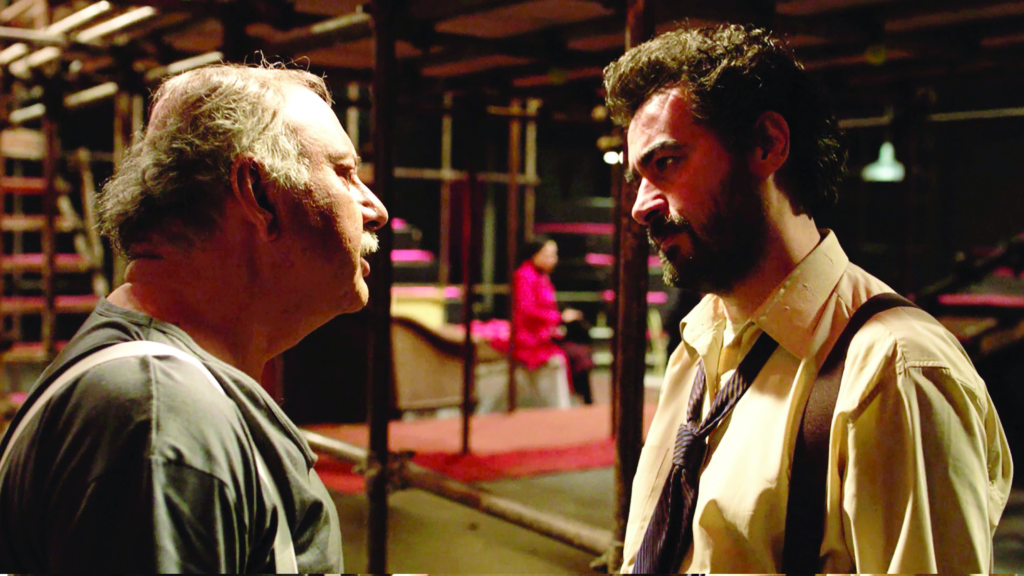
Farhadi’s previous two works, A Separation (2011) and the French-language The Past (2013), balance on the knife edge between a realist sensibility and something a little more heightened and constructed. It’s possible to see his use of the Salesman production in this film as affording him licence to be more broadly theatrical – the climactic sequence ends with the lights being shut off in the couple’s abandoned apartment, in a reversal of the stage-setting that opens the film – but it’s difficult not to find this narrative a little too overdetermined.
Whether the film’s political core is a ‘noxious’ one, however, is another matter. Farhadi’s deliberate occluding of Rana’s trauma, rather than being a weaselly bit of hand-waving, seems consistent with the considerate gender politics of his prior two works. Jonathan Rosenbaum, in his Chicago Reader review of the film, writes that Farhadi ‘privileges a woman’s viewpoint without either sharing or exploring it’,[5]Jonathan Rosenbaum, ‘The Salesman’, Chicago Reader, <http://www.chicagoreader.com/chicago/the-salesman/Film?oid=23812108>, accessed 16 February 2017. and his body of work can plausibly be regarded as being concerned with delineating – but not intruding on – the private spheres of women within a patriarchal society.
The Salesman, as with Farhadi’s previous two films, transforms slowly from a domestic drama into a kind of detective story, as the male protagonist attempts to uncover the particulars of a woman’s experience that have been withheld from him. That this investigation rides roughshod over the woman’s reasons for concealing that experience is part of Farhadi’s tacit critique of his male characters. A Separation eventually comes to focus on the possible culpability of Nader (Peyman Moaadi) for the miscarriage of a woman, Razieh (Sareh Bayat), whom he had hired to take care of his elderly father. In The Past, the future of the central couple, Marie (Bérénice Bejo) and Samir (Tahar Rahim), hinges on the question of why Samir’s comatose wife attempted suicide, and whether she had been told of his affair with Marie – and by whom.
Each of these three films’ ‘mysteries’ is a structuring absence within its respective dramatic scenario, and each suggests Farhadi’s interest in the compromised position of women within patriarchal societies. The rape, the miscarriage and the suicidal behaviour are either caused or circumscribed by the privilege of men, yet they are also events that the affected women are conditioned to withhold from the men around them – due to shame or fear or their disadvantaged status within the male-dominated environment. When Farhadi’s male protagonists attempt to penetrate these secrets, they are likewise attempting to escape, impossibly, their own position of responsibility for the patriarchal climate that has led to these events, while also, in effect, wielding the authority of their privilege to violate one of the last avenues of agency available to the affected woman: the decision to keep a traumatic experience private.
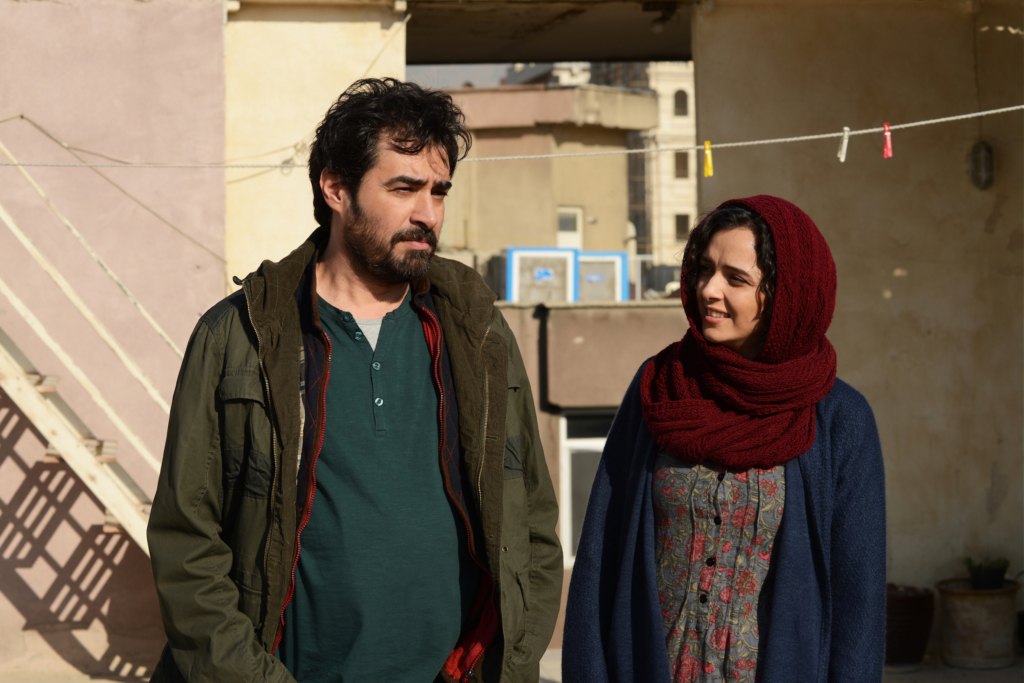
Farhadi is not necessarily interested in condemning this behaviour – he is scrupulously even-handed in writing his characters. Rather, he pays careful attention to articulating the social structures that lead to this gender imbalance. It’s here that the theatrical conceit in Salesman yields further dividends. In the parallels between the abandoned apartment and the theatrical set, Farhadi seems to suggest an erasure of the line between the private space of domesticity and the public space of performance. Even the new apartment that Babak offers Emad and Rana appears raised high above the rest: exposed and open to scrutiny. In Farhadi’s urban Iran, neighbours, co-workers and friends are a constant nearby presence – barely out of sight or earshot – contributing to the silent pressure on his characters to respond to events in a socially conforming manner, despite the psychological tensions this produces.
The final shots of the film show Rana and Emad sitting apart – their relationship now in question after their fraught confrontation with the attacker – having their make-up prepared for the play. The technicians grey their hair, apply wrinkles and age them up into their roles as Miller’s archetypal husband and wife. Consigned to performance, they cannot stop playing a part.
https://clickv.ie/w/metro/the-salesman
Endnotes
| 1 | David Jenkins, ‘The Salesman – First Look Review’, Little White Lies, <http://lwlies.com/festivals/the-salesman-first-look-review/>, accessed 16 February 2017. |
|---|---|
| 2 | Vadim Rizov, ‘TIFF Critic’s Notebook 0: The Salesman, Aquarius, Things to Come, Elle’, Filmmaker Magazine, 7 September 2016, <http://filmmakermagazine.com/99464-tiff-critics-notebook-0-the-salesman-aquarius-things-to-come-elle/>, accessed 16 February 2017. |
| 3 | Bilge Ebiri, ‘Cannes 2016 Winners Highlight the Gulf Between Critics and the World’, The Village Voice, 23 May 2016, <http://www.villagevoice.com/film/cannes-2016-winners-highlight-the-gulf-between-critics-and-the-world-8651054>, accessed 16 February 2017. |
| 4 | Mike D’Angelo, ‘Closing Cannes with Farhadi, Verhoeven, and Best-of-the-fest Picks’, The A.V. Club, 21 May 2016, <http://www.avclub.com/article/closing-cannes-farhadi-verhoeven-and-best-fest-pic-237141>, accessed 3 March 2017. |
| 5 | Jonathan Rosenbaum, ‘The Salesman’, Chicago Reader, <http://www.chicagoreader.com/chicago/the-salesman/Film?oid=23812108>, accessed 16 February 2017. |
